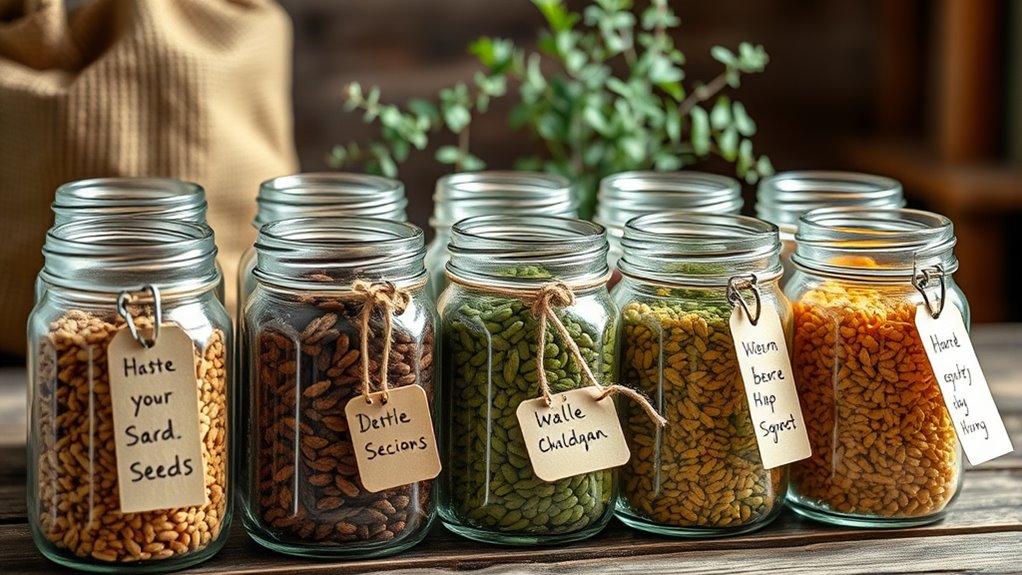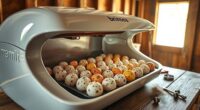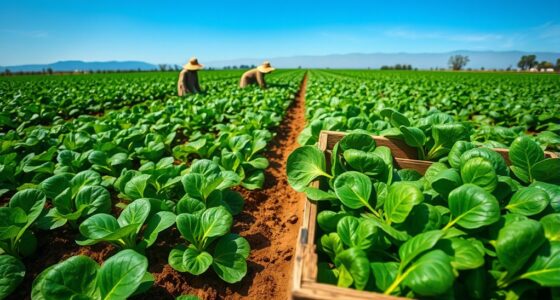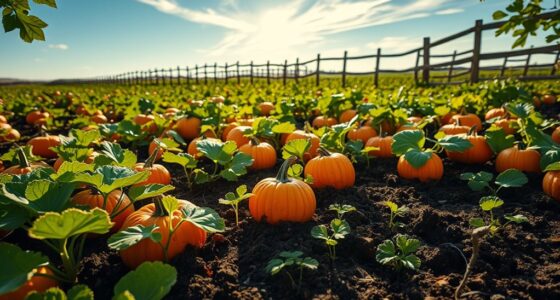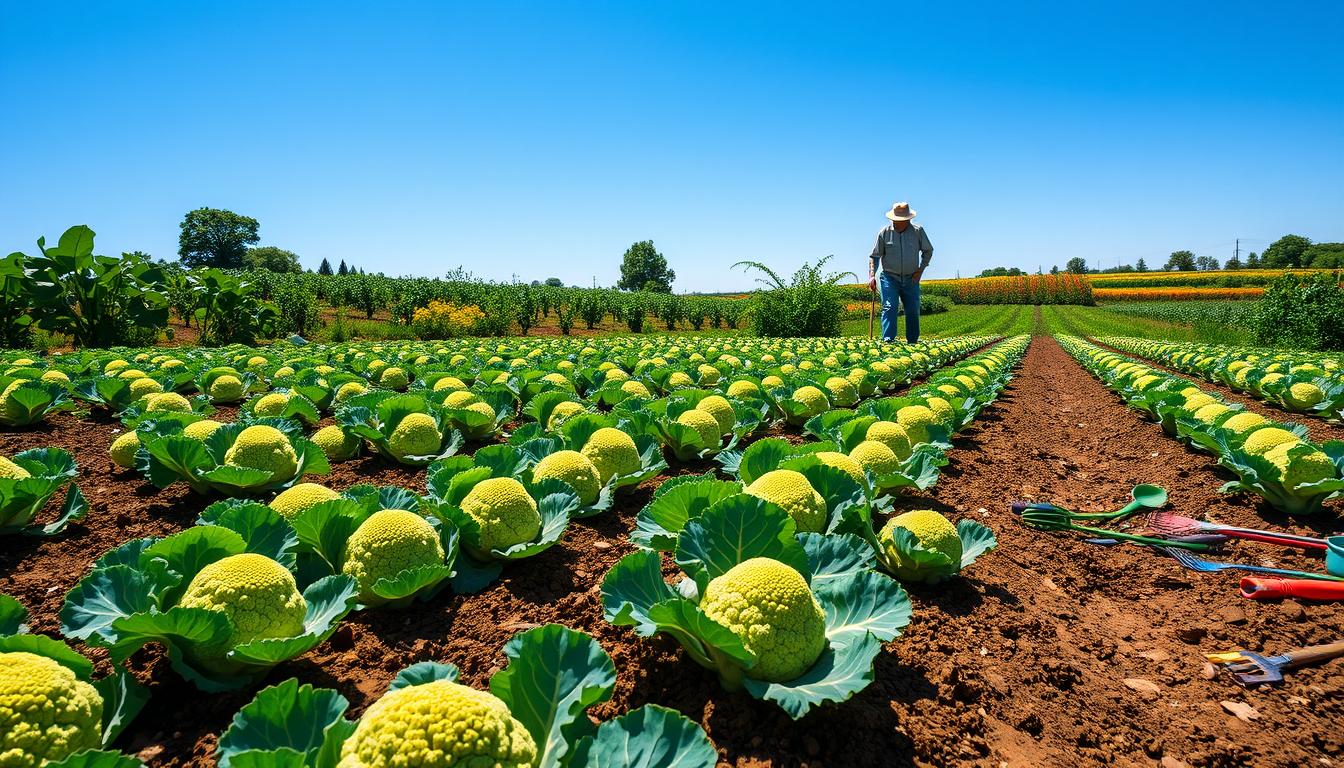To store seeds for long-term use, keep them in airtight containers, like glass jars or vacuum-sealed bags. Aim for a cool temperature between 35-40°F, ideally in the fridge, and store them in a dark place to prevent sprouting. Adding silica gel packets helps keep humidity under 60%. Remember to check for pests and moisture regularly. Performing germination tests on older seeds can also guarantee their viability. You'll discover more useful tips for successful seed storage!
Key Takeaways
- Store seeds in airtight containers, such as glass jars or vacuum-sealed bags, to protect against moisture and pests.
- Maintain a storage temperature between 35-40°F; refrigeration is best for preserving seed viability.
- Keep seeds in a dark place to prevent premature sprouting and degradation of quality.
- Add silica gel packets to reduce humidity levels below 60%, ensuring optimal storage conditions.
- Regularly check seeds for signs of moisture or pests, and conduct germination tests on older seeds before planting.
Importance of Proper Seed Storage
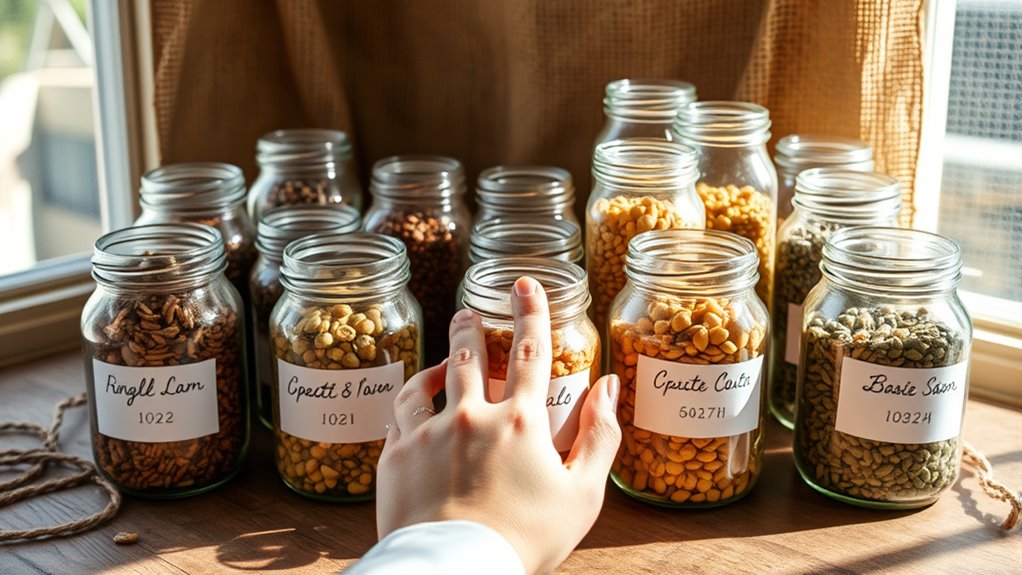
Proper seed storage is essential for maintaining the life of your seeds. Proper storage helps preserve quality and guarantees their viability over time.
When you store seeds in airtight containers, you protect them from moisture and pests, two critical factors that can lead to decay. By keeping seeds in a cool, dark place, you create an ideal environment, enhancing their germination rates.
Neglecting these conditions can result in decreased viability, meaning your seeds mightn't sprout when you need them. Long-term seed storage can be successful if you regularly monitor the temperature and moisture levels.
With the right practices, seeds like beans and peas can remain viable for up to 10-15 years, guaranteeing a bountiful garden for years to come.
Best Conditions for Storing Seeds

To guarantee your seeds remain viable for years, it's crucial to create the right storage conditions. Use airtight containers, like glass jars or vacuum-sealed bags, to shield your seeds from moisture, light, and pests.
Ensure your seeds stay viable by storing them in airtight containers, protecting them from moisture, light, and pests.
Aim for a peak temperature between 35-40°F; refrigeration is perfect for long-term seed storage. Always let seeds reach room temperature before use to avoid moisture condensation.
Store your seeds in a dark place to prevent premature sprouting—opaque containers or cabinets work best. To manage moisture levels, consider adding silica gel packets to keep humidity below 60%.
Regularly monitor your stored seeds for pests and moisture, and conduct germination tests to guarantee continued seed viability for your planting needs.
Freezing Seeds for Long-term Storage

Freezing seeds can be an excellent way to guarantee their longevity, provided you follow a few key steps.
Start by ensuring your seeds are completely dry before placing them in airtight containers, like mason jars, and freezing them at 0°F for long-term storage.
To maintain seed viability, store seeds at the back of the freezer to minimize temperature fluctuations.
Before using frozen seeds, let them reach room temperature, leaving the jars open for a few days to prevent moisture condensation.
Avoid repeatedly transferring them between the freezer and room temperature, as this can harm their viability.
For extra protection, consider vacuum sealing the jars or adding moisture-absorbing gel packets to keep conditions dry.
Organizing Seeds for Easy Access

When you organize your seeds effectively, you not only protect them from moisture and pests but also make it easier to find what you need when planting season arrives.
Start by using airtight containers like mason jars or vacuum-sealed bags for easy access and visibility. Be sure to label each seed packet or container with the seed type and storage date to track viability.
Consider grouping seeds by type or planting season, which streamlines your selection process. A card catalog system works well, storing seed packets upright in rectangular containers for quick browsing.
Regularly check for signs of moisture or pests, and maintain an inventory list to monitor the age and condition of your seeds for ideal planting success.
Tips for Ensuring Seed Viability

Guaranteeing seed viability requires careful attention to storage conditions, so you'll want to keep your seeds in airtight containers at temperatures of 40 degrees Fahrenheit or lower. This helps extend their lifespan considerably.
Maintain humidity levels below 60% by adding silica gel packets to prevent moisture from causing premature sprouting and decay. Store your seeds in dark, opaque containers to protect them from light exposure, which can trigger germination.
Regularly inspect your seeds for signs of moisture or pest infestations. If you find pests, freeze the infested seeds for 5-7 days to eliminate them without compromising seed viability.
Before planting, perform germination tests on older seeds to guarantee ideal growth and successful crop establishment.
Frequently Asked Questions
What Is the Best Way to Store Seeds Long Term?
To store seeds long-term, you'll want to use airtight containers like mason jars or vacuum-sealed bags.
Keep them in a dark, cool place at 40 degrees Fahrenheit or lower.
Before sealing, make certain the seeds are completely dry to prevent mold or sprouting.
Regularly check for moisture or pests, and consider using silica gel packets.
Finally, test germination to guarantee your seeds remain viable when you're ready to plant them.
Will 20 Year Old Seeds Grow?
You might find that 20-year-old seeds can still grow, but their chances of germination are slim.
Many seeds lose viability over time, especially after 5 to 10 years. The success largely depends on the seed type; some, like beans, may last longer.
Before planting, it's wise to conduct a germination test to check if they'll sprout.
While some gardeners have had luck, using fresher seeds is always the better option for robust growth.
What Is the Best Method of Seed Storage?
Imagine you're prepping for a post-apocalyptic garden, and you want your seeds to last. The best method of seed storage involves using airtight containers like mason jars or vacuum-sealed bags.
Keep your seeds in a cool, dark place at temperatures below 40°F. Adding silica gel packets helps absorb moisture.
For even longer storage, freezing dry seeds in sealed jars at 0°F can keep them viable for years. Regularly check for pests or moisture!
Is It Better to Store Seeds in Paper or Plastic?
When deciding whether to store seeds in paper or plastic, consider your specific needs.
Paper envelopes can absorb moisture and provide breathability, but they risk humidity affecting seed viability.
On the other hand, airtight plastic containers protect against moisture and pests, though they can trap humidity if seeds aren't completely dry.
Mixing both methods can balance moisture control and air circulation, keeping your seeds viable for longer.
Always check for condensation, especially in plastic.
Conclusion
In the world of gardening, the old adage "a stitch in time saves nine" rings true for seed storage. By taking the right steps to store your seeds properly, you can guarantee they remain viable for years to come. Remember to keep them in a cool, dark, and dry place, and don't hesitate to freeze them for added longevity. With a little organization, you'll always have the seeds you need for your next planting adventure.

